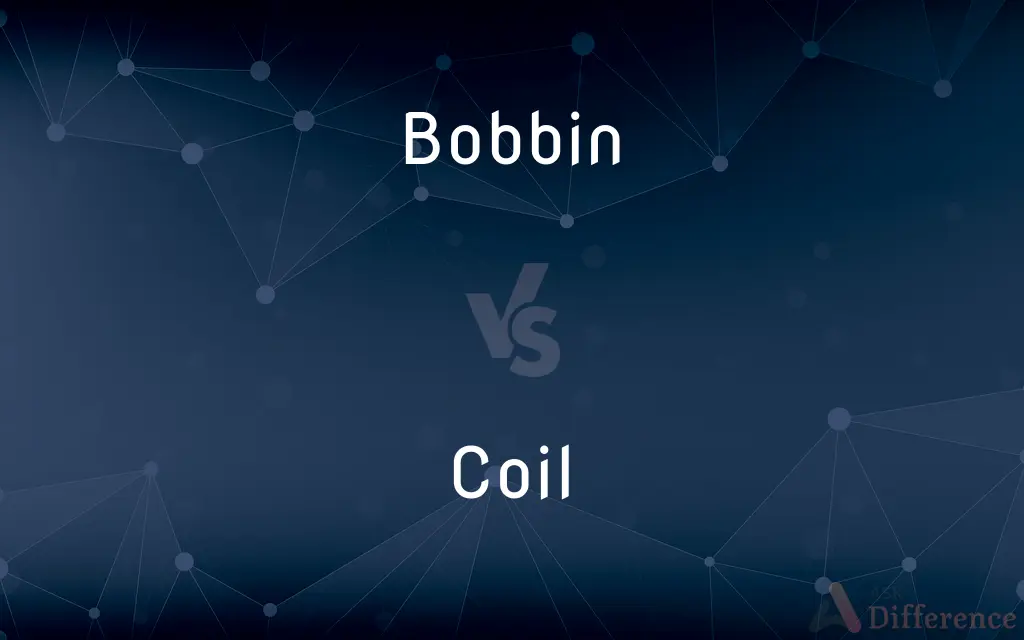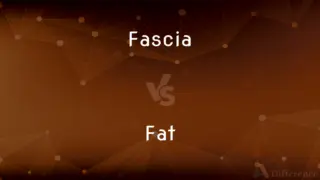Bobbin vs. Coil — What's the Difference?
By Maham Liaqat & Urooj Arif — Updated on May 6, 2024
Bobbin primarily refers to a spool for winding thread, while a coil is often a series of loops, commonly used in electromagnetics.

Difference Between Bobbin and Coil
Table of Contents
ADVERTISEMENT
Key Differences
A bobbin is typically used in sewing machines and textiles to hold thread, yarn, or wire, facilitating orderly use and storage, whereas a coil, in electrical engineering, refers to wire wound in a series of loops to create an electromagnetic field when electric current passes through it.
Bobbins are generally cylindrical with flanges, and are made from plastic, wood, or metal, designed to fit specific machinery like sewing machines; on the other hand, coils can be wound into various shapes (e.g., circular, spiral) and sizes depending on their application, such as inductors or solenoids in electronic devices.
While bobbins are essential in the textile industry for tasks like sewing and weaving, providing a means to manage thread or yarn efficiently, coils are crucial in electronics and electrical applications, where they are used to induce magnetic fields, as in motors or transformers.
The functionality of bobbins is mechanical, aiming to store thread neatly and prevent tangles, whereas the purpose of coils is primarily electromagnetic, crucial for functions like energy transformation and signal processing.
In terms of variations, bobbins can differ in size and material based on the sewing equipment or industrial requirements, while coils vary widely in wire gauge, material type (such as copper or aluminum), and insulation, tailored to specific electrical characteristics and performance needs.
ADVERTISEMENT
Comparison Chart
Primary Use
Holding thread in sewing and weaving
Generating magnetic fields, transferring energy
Shape
Typically cylindrical with flanges
Can be various shapes like circular or spiral
Material
Plastic, wood, metal
Copper, aluminum (usually with insulation)
Industry
Textile
Electronics, electrical engineering
Function
Mechanical storage and dispensation of thread
Electromagnetic induction, signal processing
Compare with Definitions
Bobbin
Historical use in telegraphy for insulating wires.
The old telegraph machine featured wooden bobbins to separate the wires.
Coil
A spiral form or series of loops.
She fashioned the wire into a tight coil to create the sculpture.
Bobbin
A component in lace making.
Each bobbin was carefully wound with fine thread for making delicate lace patterns.
Coil
An arrangement of loops of wire, often wound around a core, to produce a magnetic field.
The transformer contains a primary coil that converts the high voltage to a lower one.
Bobbin
Used in fishing reels.
He checked the bobbin for any signs of wear and tear before heading out to fish.
Coil
An automotive part in the ignition system.
The mechanic diagnosed the problem as a faulty ignition coil.
Bobbin
A cylinder or cone holding thread, yarn, or wire, used industrially.
The factory machines were equipped with large bobbins for weaving carpets.
Coil
A heating or cooling element in appliances.
The technician checked the air conditioner's coil for leaks.
Bobbin
A small spool used in sewing machines to hold thread.
She replaced the empty bobbin with a full one to continue sewing.
Coil
Used in electronic components like inductors and solenoids.
He soldered a new coil onto the circuit board to replace the burnt-out one.
Bobbin
A bobbin is a spindle or cylinder, with or without flanges, on which wire, yarn, thread or film is wound. Bobbins are typically found in sewing machines, cameras, and within electronic equipment.
Coil
A series of connected spirals or concentric rings formed by gathering or winding
A coil of rope.
Long coils of hair.
Bobbin
A spool or reel that holds thread or yarn for spinning, weaving, knitting, sewing, or making lace.
Coil
An individual spiral or ring within such a series.
Bobbin
Narrow braid formerly used as trimming.
Coil
A spiral pipe or series of spiral pipes, as in a radiator.
Bobbin
A spool or cylinder around which wire is coiled.
Coil
A wound spiral of two or more turns of insulated wire, used to introduce inductance into a circuit.
Bobbin
In a sewing machine, the small spool that holds the lower thread.
Wind the bobbin, place it in the machine, and raise the thread.
Coil
Any of various devices of which such a spiral is the major component.
Bobbin
The little rounded piece of wood at the end of a latch string, which is pulled to raise the latch.
Coil
A roll of postage stamps prepared for use in a vending machine.
Bobbin
(haberdashery) A fine cord or narrow braid.
Coil
A disturbance; a fuss.
Bobbin
A small pin, or cylinder, formerly of bone, now most commonly of wood, used in the making of pillow lace. Each thread is wound on a separate bobbin which hangs down holding the thread at a slight tension.
Coil
To wind in concentric rings or spirals.
Bobbin
A spool or reel of various material and construction, with a head at one or both ends, and sometimes with a hole bored through its length by which it may be placed on a spindle or pivot. It is used to hold yarn or thread, as in spinning or warping machines, looms, sewing machines, etc.
Coil
To wind into a shape resembling a coil.
Bobbin
The little rounded piece of wood, at the end of a latch string, which is pulled to raise the latch.
Coil
To form concentric rings or spirals.
Bobbin
A fine cord or narrow braid.
Coil
To move in a spiral course
Black smoke coiling up into the sky.
Bobbin
A cylindrical or spool-shaped coil or insulated wire, usually containing a core of soft iron which becomes magnetic when the wire is traversed by an electrical current.
Coil
Something wound in the form of a helix or spiral.
The sinuous coils of a snake
Bobbin
A winder around which thread or tape or film or other flexible materials can be wound
Coil
Any intrauterine device (Abbreviation: IUD)—the first IUDs were coil-shaped.
Coil
(electronics) A coil of electrically conductive wire through which electricity can flow.
Coil
A cylinder of clay.
Coil
(figurative) Entanglement; perplexity.
Coil
A noise, tumult, bustle, or turmoil.
Coil
To wind or reel e.g. a wire or rope into regular rings, often around a centerpiece.
A simple transformer can be made by coiling two pieces of insulated copper wire around an iron heart.
Coil
To wind into loops (roughly) around a common center.
The sailor coiled the free end of the hawser on the pier.
Coil
To wind cylindrically or spirally.
To coil a rope when not in use
The snake coiled itself before springing.
Coil
To build a pot (etc) with clay coils.
Coil
To encircle and hold with, or as if with, coils.
Coil
To wind cylindrically or spirally; as, to coil a rope when not in use; the snake coiled itself before springing.
Coil
To encircle and hold with, or as with, coils.
Coil
To wind itself cylindrically or spirally; to form a coil; to wind; - often with about or around.
You can see his flery serpents . . . Coiting, playing in the water.
Coil
A ring, series of rings, or spiral, into which a rope, or other like thing, is wound.
The wild grapevines that twisted their coils from trec to tree.
Coil
Fig.: Entanglement; toil; mesh; perplexity.
Coil
A series of connected pipes in rows or layers, as in a steam heating apparatus.
Coil
A noise, tumult, bustle, or confusion.
Coil
A structure consisting of something wound in a continuous series of loops;
A coil of rope
Coil
A round shape formed by a series of concentric circles
Coil
A transformer that supplies high voltage to spark plugs in a gasoline engine
Coil
A contraceptive device placed inside a woman's womb
Coil
Tubing that is wound in a spiral
Coil
Reactor consisting of a spiral of insulated wire that introduces inductance into a circuit
Coil
To wind or move in a spiral course;
The muscles and nerves of his fine drawn body were coiling for action
Black smoke coiling up into the sky
The young people gyrated on the dance floor
Coil
Make without a potter's wheel;
This famous potter hand-builds all of her vessels
Coil
Wind around something in coils or loops
Common Curiosities
Can bobbins affect the quality of sewing or weaving?
Yes, the quality and condition of bobbins can significantly impact the tension and distribution of thread or yarn, thus affecting the overall quality of sewing or weaving.
How does the design of a coil influence its function?
The design of a coil, including its shape, the number of turns, and the type of material, directly affects its inductance and the strength of the magnetic field it can produce.
What are the environmental considerations for disposing of bobbins and coils?
Disposal of bobbins and coils involves considering the materials they are made of; plastic and metal bobbins are often recyclable, whereas coils, especially those with copper wiring, need to be disposed of in accordance with electronic waste regulations.
How are bobbins typically made?
Bobbins are typically manufactured from materials like plastic, metal, or wood and are shaped to fit specific types of machinery, with precise dimensions for flanges and cores.
What safety precautions are necessary when handling coils?
Safety precautions for handling coils include ensuring all power sources are disconnected to avoid electrical shock, and using protective gear when dealing with high-voltage coils.
What kinds of devices use coils?
Devices that use coils include electric motors, transformers, inductors, solenoids, and various electronic components found in consumer electronics and industrial equipment.
How often should bobbins be replaced?
The replacement schedule for bobbins depends on the frequency of use and the visible wear and tear; however, they typically have a long lifespan in low-stress environments like home sewing.
What are the common issues encountered with coils?
Common issues with coils include overheating, insulation failure, and physical damage to the windings, all of which can affect performance and safety.
Are there different types of bobbins?
Yes, there are several types of bobbins, including those used in sewing machines, industrial weaving looms, and lace making, each designed for specific threads and functionalities.
How can one determine the correct bobbin for a sewing machine?
To determine the correct bobbin for a sewing machine, check the machine's manual for the manufacturer's specifications or consult with a sewing supplies specialist to ensure compatibility and proper functioning.
Share Your Discovery

Previous Comparison
View vs. Watch
Next Comparison
Fascia vs. FatAuthor Spotlight
Written by
Maham LiaqatCo-written by
Urooj ArifUrooj is a skilled content writer at Ask Difference, known for her exceptional ability to simplify complex topics into engaging and informative content. With a passion for research and a flair for clear, concise writing, she consistently delivers articles that resonate with our diverse audience.
















































